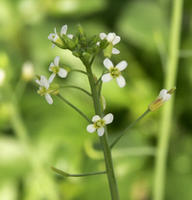TRANSNET

Transcriptional networks and their evolution in the Brassicaceae
The TRANSNET project is a URGI genome dynamics research project whose goal is to exploit recent developments in DNA sequencing technology together with state of the art bioinformatics to derive the transcriptional networks regulating important agronomic traits from comparative analysis of Arabidopsis and its relatives.
URGI team: Hadi Quesneville, Matthias Zytnicki, Claire Hoede, Olivier Inizan, and Florian Maumus, with the help of URGI support team
Introduction
Transcriptional control is the single most important regulatory mechanisms in all organisms. It ultimately depends on transcription factors (TF) that recognise cis-regulatory elements within their targets. Due to their importance in the control of gene activity, transcription factors and cis-regulatory motifs play a pivotal role in evolution and have enormous biotechnological potential.
Our aims are to identify key promoter motifs associated with particular gene expression patterns, to directly determine the number of binding sites for selected TFs across the genomes of these species and to determine how conserved the number and positions of these sites are between the species.
On the other hand, another layer of regulation of gene expression is that determined by chromatin structure, which controls promoter accessibility. In this context, an additional objective of the project is to map along these genomes relevant histone modifications and DNA methylation, and to determine the degree of conservation of the epigenome across species.
The unique data set generated together with the close interactions between bioinformatic and experimental groups will provide insights on the architecture of particular transcriptional networks and on how they evolve in plants. Additionally, it will provide key information on combinatorial action of TFs, reflected in the non-random presence of other cis-motifs in the target genes of a particular TF.
Specific aims
Sequencing and annotation of the Arabis alpina genome
Three particularly appropriate species have been selected for this programme based on their positions in the phylogeny of the Brassicaceae and our preliminary data. These are Arabidopsis thaliana, as the reference species, Arabidopsis lyrata, which is closely related to Arabidopsis thaliana and whose genome has recently been sequenced, and Arabis alpina which is more distantly related to Arabidopsis and whose genome will be sequenced in this programme.
Identification of regulatory elements by combining Solexa sequencing and in silico analysis followed by experimental verification.
This study will be performed on specific biological topics – phosphate starvation, flowering, germination, which represent major foci of the partners of this consortium.
Experimental determination of transcription factor binding sites and chromatin marks across three genomes to test predictions made in section B and further improve bioinformatic approaches.
This analysis will be based on the CHIP-seq approach. Comparison of experimentally verified TF binding sites with those predicted from in silico analysis in section B will help to improve in silico predictions. Additionally, mapping of DNA methylation and 3 histone modifications will inform on the relevance of chromatin modification status in the determination of conservation/divergence in gene expression.
In silico building of regulatory networks
We aim to build predicted A. thaliana regulatory networks for phosphate starvation, flowering control and germination based on all above data sets – expression data, predicted TF target sites, confirmed TF target sites, epigenomic maps.
Duration: 01/01/2009 to 31/12/2011
Coordinator: Georges Coupland
Partners
We have brought together a multidisciplinary consortium with a complementary set of expertises in biology, genomics and bioinformatics to reach these goals and form the basis of a Systems biology approach. Predictions made by the bioinformatics groups will be tested by the experimental groups and the results of the experiments used to improve the bioinformatic approaches. The project is therefore based on complementary expertise of the participants and on an inter play between computational and lab-based approaches.
| George | Coupland | Max Planck Institute for Plant Breeding Research, Koeln, Germany |
| Javier | Paz-Ares | Centro Nacional de Biotecnologia-CSIC, Campus de Cantoblanco, 28049 Madrid, Spain |
| Pilar | Carbonero | Universidad Politécnica de Madrid, Depto Biotecnología, E. T. S. I. Agrónomos, 28040 Madrid, Spain |
| Vincent | Colot | Biologie moléculaire des organismes photosynthétiques – UMR8186, Ecole Normal Supérieur, Paris, France |
| Detlef | Weigel | Max Planck Institute for Developmental Biology, Tuebingen, Germany |
| Alexander | Kel | SVP R&D, BIOBASE GmbH,Wolfenbuettel, Germany |
| Hadi | Quesneville | Unité de recherche en Génomique Info - URGI, UR 1164, INRA, Versailles, France |
Results
The results have commercial applications in enabling a commercial partner to improve their algorithms for identification of regulatory motifs in plant genomes and more generally provide important insights into the architecture of transcriptional networks as well as their significance in the context of evolution thereby indicating approaches to precisely engineer important traits.
Resources
The URGI hosts several resources concerning A. alpina:
- a GBrowse ,
- a GBrowse-syn with A. thaliana, A. lyrata and A. alpina,
- an Apollo for genome annotation.
- a Blast server provided by the MPI at Cologne (ask: velikkakam [at] mpipz [dot] mpg [dot] de).
Please read the annotation protocol:
before using Apollo.
